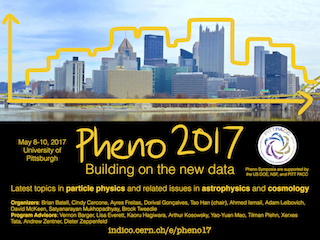Searches for supersymmetry are presented based on the electroweak pair production of neutralinos and charginos in different decay modes of gauginos and sleptons, through intermediate vector bosons or Higgs bosons, or directly to leptons. The data sample corresponds to an integrated luminosity of 35.9 fb$^{-1}$ of pp collisions at a center-of-mass energy of 13 TeV collected in 2016 with the CMS...
Supersymmetry models with light electroweak sparticles are well motivated by naturalness and have less stringent exclusion limits on the supersymmetric particle masses than strong production. ATLAS searches for electroweak production of supersymmetric particles in a number of channels, which include multiple leptons and therefore benefit from lower numbers of background process events. Results...
Supersymmetry has not been observed thus far, which implies that SUSY scale is higher than it was expected before the LHC era. Further, the observation of the Higgs boson mass at $\sim 125$ GeV, implies that the loop correction to the Higgs mass in SUSY is sizable, which in turn also implies a large SUSY scale. An important contributing factor to the non-observation of SUSY is that in most...
In supersymmetry, most solutions to the hierarchy problem feature relatively
light gluinos. For the first time in history we can probe these gluino masses up
to 2 TeV. This talk will motivate searches for gluinos and present search
results and techniques, that focus on supersymmetric models where the gluinos
are believed to be relatively light and that have either one lepton or two
oppositely...
Searches for supersymmetry at the Large Hadron Collider in electroweak final states are kinematically limited by softness of the leptonic scattering products in the regime of narrow mass splitting between the slepton and neutralino. After requiring a hard initial-state jet in order to provide the visible system a large transverse boost, we cut on the reconstructed OSSF dilepton mass, as well...
This talk presents results of searches for supersymmetry in events with photons. The final states considered are particularly motivated by generalized models of gauge-mediated supersymmetry breaking with a gravitino as the lightest supersymmetric particle. The data samples are recorded with the CMS detector at a center-of-mass energy of 13TeV. Results are interpreted in various models.
R-parity violation introduces many viable signatures to the search for supersymmetry at the LHC. Strongly interacting resonances and lightest supersymmetric particles may decay into many leptons or jets with or without missing transverse momentum. Several supersymmetric models also predict massive long-lived supersymmetric particles. Such particles may be detected through abnormal specific...
This project explores limits on a baryon number violating R-parity-violating (RPV) extension of the s-channel production of top squarks, examining it's R-parity-conserving decay into a bottom quark, a lepton, and missing energy. Using Monte Carlo simulations I calculate upper bounds for the RPV parameter $\lambda_{ijk}^{''}$ for a range of top squark masses that would allow for it's existence.
